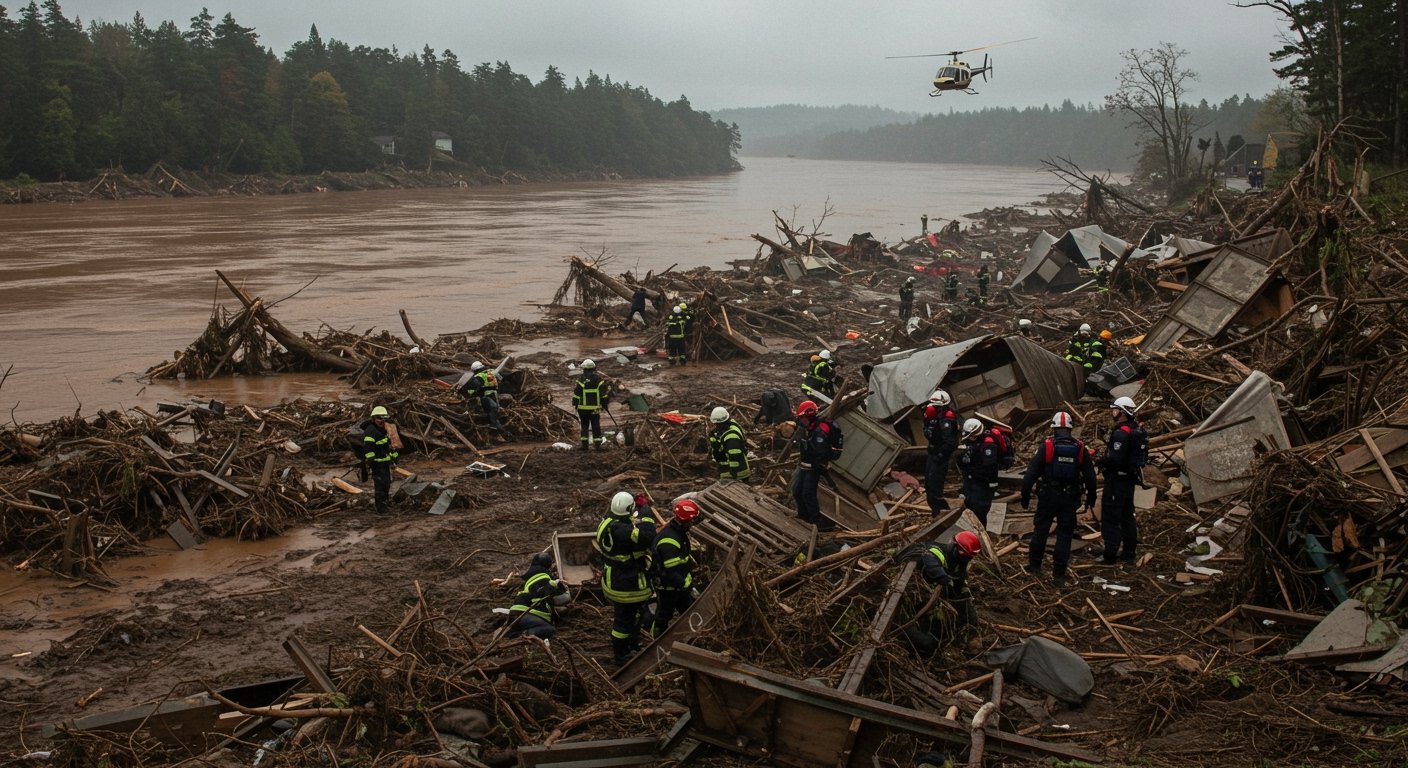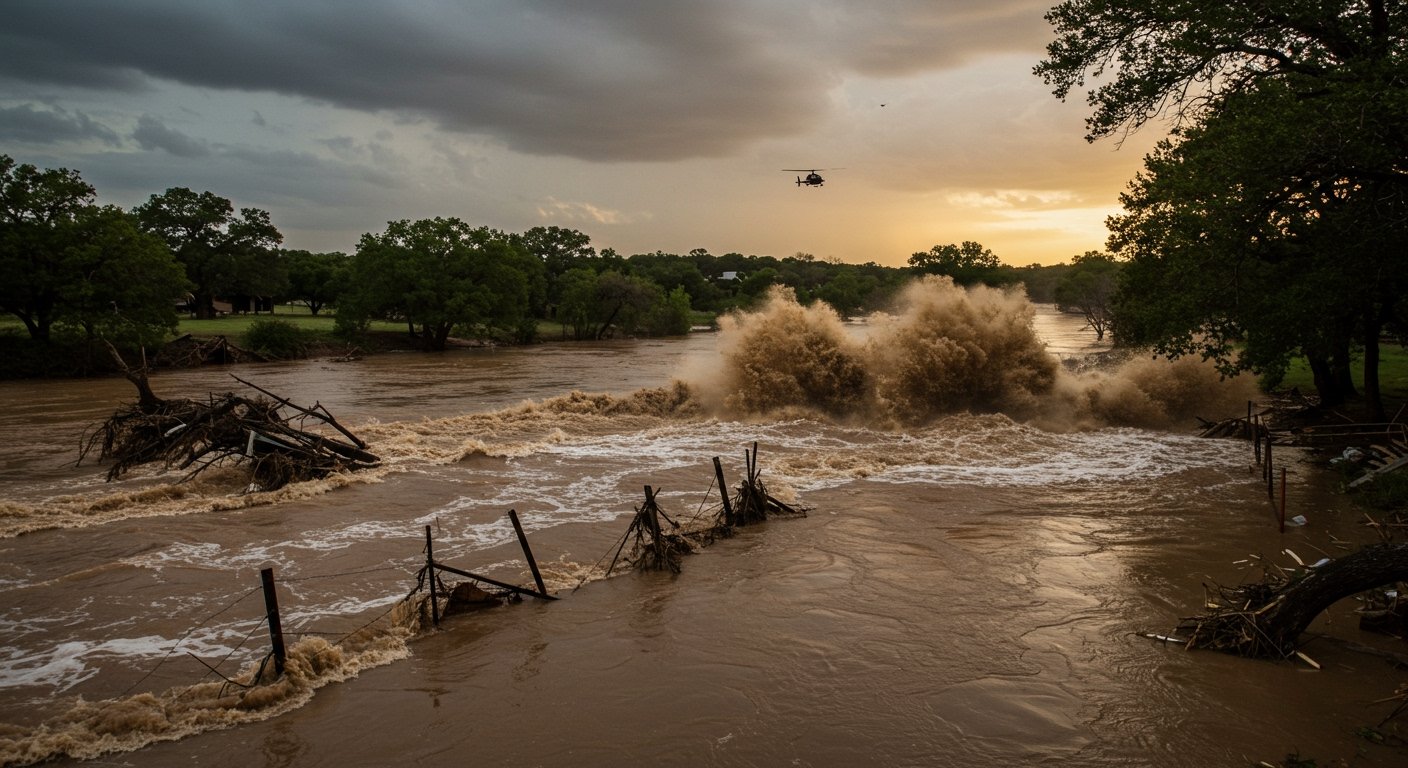Central Texas is grappling with the devastating aftermath of catastrophic flash flooding along the Guadalupe River, primarily impacting Kerr County. The sudden and violent surge of water has resulted in a confirmed death toll of at least 51 people, including a significant number of children. Rescuers are engaged in a relentless, albeit increasingly bleak, search for survivors across a wide expanse of devastated landscape.
Among the gravest concerns is the fate of 27 girls still missing from Camp Mystic, a Christian summer camp situated directly on the riverbanks. Most of the deceased recovered so far were found in areas around this camp, highlighting the immense and concentrated impact of the flood on the facility and its occupants.
The Deluge and Its Rapid Rise
The destructive flooding commenced before sunrise on Friday, July 4, transforming what should have been a holiday weekend into a scene of unprecedented natural disaster. Torrential rain systems converged over the region, overwhelming rivers and tributaries. The Guadalupe River, a central waterway through Kerr County, experienced a particularly dramatic and sudden rise. Data from one river gauge captured the astonishing speed of the event, recording a 26-foot rise in the water level in just 45 minutes.
This rapid ascent gave residents and campers little time to react or evacuate, contributing significantly to the high number of casualties and those trapped by the rising waters. The sheer volume and velocity of the water caused widespread destruction, tearing structures from their foundations, scouring the landscape, and depositing debris over vast areas.
The Search for Survivors
In the wake of the flood, a massive search and rescue operation was immediately launched. Emergency responders, aided by volunteers, have been navigating hazardous conditions – including swift currents, submerged vehicles, and unstable structures – in their efforts to locate survivors. The operation spans the entire affected region, with particular focus on the areas hardest hit by the flood’s primary surge, including the vicinity of Camp Mystic.
Despite the tragic loss of life, rescue efforts have been successful in saving hundreds of individuals. According to official reports, over 850 people have been rescued across the affected region since the flooding began. These rescues have involved various methods, including helicopter lifts from rooftops and vehicles, swift-water boat teams, and on-the-ground searches through flooded areas. The scale of the rescues underscores the widespread nature of the emergency and the bravery of the responding teams.
However, as days pass, the search for the 27 missing girls from Camp Mystic and others still unaccounted for grows more difficult. The debris field is extensive, and the sheer force of the water means individuals could have been carried significant distances. Rescuers continue their systematic search, holding onto fading hope while preparing for the grim reality that the death toll could rise further.
Questions Over Warnings and Preparedness
In the aftermath of the tragedy, questions are being raised regarding the timing and adequacy of warnings issued to residents and institutions like Camp Mystic before the floodwaters surged. Some observers and affected families have questioned whether there was sufficient notice or if warnings were disseminated effectively enough given the extreme nature and speed of the impending flood.
Officials responsible for emergency management and meteorological forecasting have defended their actions, stating that appropriate warnings were issued based on the information available at the time. They highlight the unpredictable and rapidly developing nature of flash floods, particularly in areas prone to sudden river rises due to intense, localized rainfall. The debate over preparedness is likely to continue as investigations into the disaster unfold.
State Response and Call for Prayer
Texas Governor Greg Abbott has acknowledged the profound impact of the disaster on the state. In response to the tragedy and the widespread grief, Governor Abbott has declared Sunday, July 6, 2025, as a statewide Day of Prayer for those affected by the catastrophic flooding. The declaration aims to provide a moment for reflection, solace, and communal support for the victims, their families, the missing, and the rescuers.
The disaster has prompted an outpouring of support from across the state and beyond, with communities mobilizing to provide aid, supplies, and assistance to the affected areas. Relief efforts are underway to support the hundreds displaced and those who have lost homes and livelihoods.
The focus remains on the ongoing search operations and supporting the families enduring unimaginable loss and uncertainty. The events of Friday, July 4, have left an indelible mark on Central Texas, serving as a stark reminder of the power of nature and the fragility of life in the face of such swift and devastating events.






